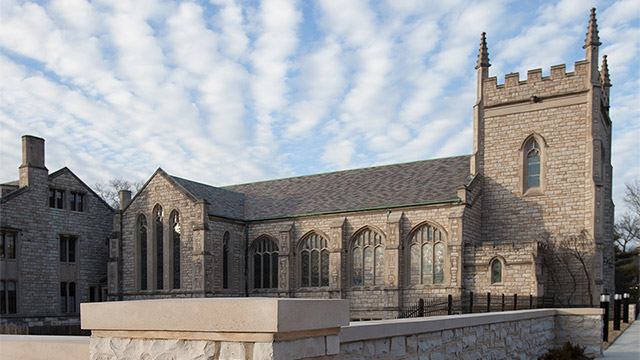Arnold Masonry helped this Clayton Congregation link their limestone church to two residential brick houses, expand parking, and teach the next generation.
August 10, 2015 7:00 AM CDT
Campus connections
Get masonry industry news in your inbox
Subscribe to Masonry Messenger to receive the masonry resources and information you need to stay current.
No Thanks
X
Creative neighborly congregation builds a campus
By
Masonry Institute of St. Louis
A church is more than a building. It is community.
When Central Presbyterian Church in Clayton, MO drafted a master plan for the modernization and expansion of its facilities, the congregation considered the impact on their residential neighbors. The church acquired adjoining property immediately to its south on Hanley Road for a parking garage, and to the west, two residential houses on a neighboring block for a new student center.
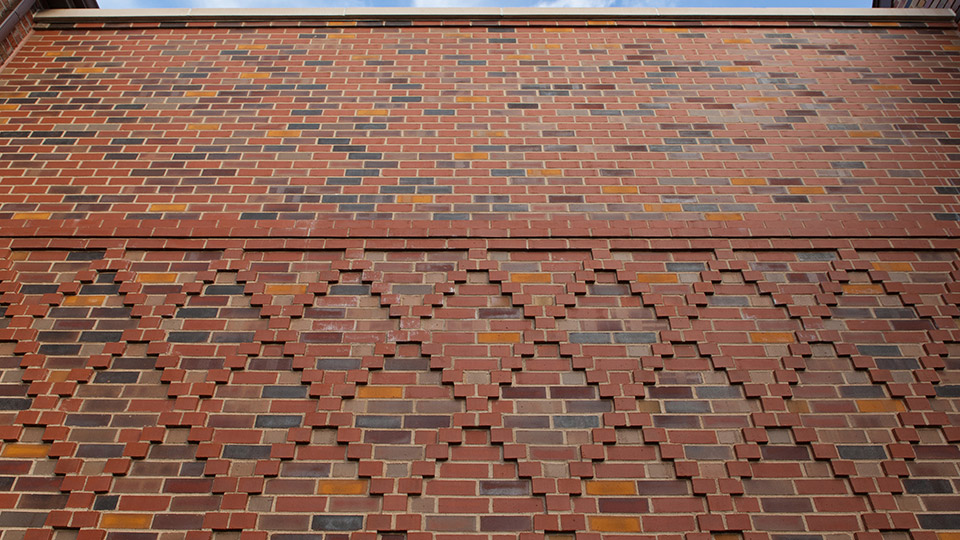
The diamond pattern on the new brick wall linking the two houses of the new student center matches an original pattern on one building’s façade.
The construction of this classic limestone church in 1930 followed the 1925 development of the neighboring Davis Place subdivision of fine brick homes. Architect Tyler Stephens of Core 10 Architects put a great deal of thought into the optimal way to make the first upgrades to these blocks in over eighty years. Part of his intent was to use, blend and interpret the style and color of the different building materials in the existing structures in order to create a cohesive campus.
“Our task was to come up with the best use for the land the church acquired for its expansion. Originally the thought was to tear everything down and build new”, said Stephens, principal at Core 10 Architects. “We decided to keep the houses on Biltmore Place, but connect them to the church to preserve the same street façade.”
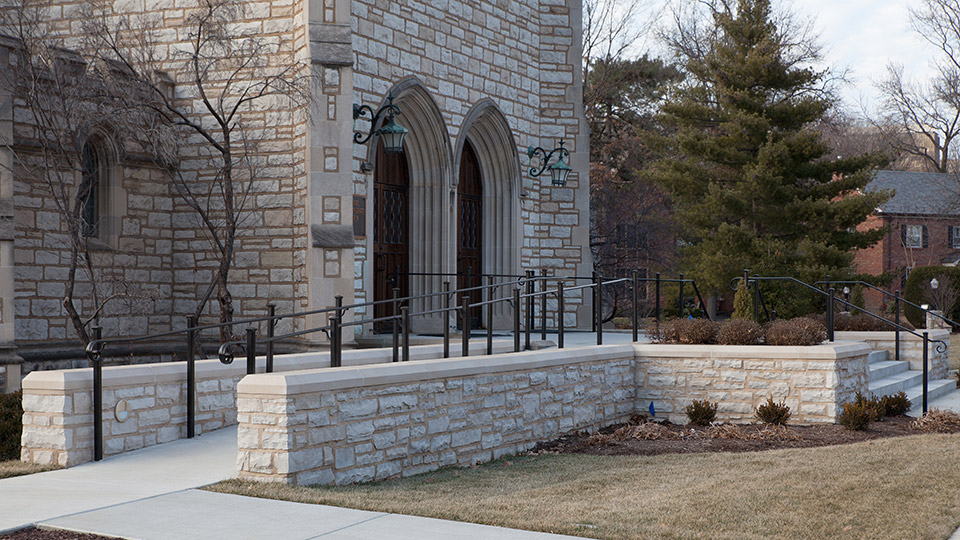
Limestone veneer around the new ADA compliant ramp and church entrance tie the new additions with the original structure. Built in 1930, the steps were removed, reconditioned and then replaced on the front of the new entry terrace.
The variety of masonry work on this sprawling project required the skilled hands of expert craftsmen. Arnold Masonry joined this project in November 2013. The only work on the church itself involved
the addition of an ADA compliant entrance ramp. The original steps connected to the church were removed and numbered for reassembly. An elevated entry terrace was built on the front of the church, widen- ing the original entrance. This allowed the new ramp that approached the church from the south to tie into the structure. CMU walls with a full depth veneer of Eden limestone from Midwest Block & Brick framed the concrete slab of the new entrance as well as the handi- capped accessible ramp. The walls are topped with precast capstones. The original steps were reconditioned and set back into place against the new concrete terrace.
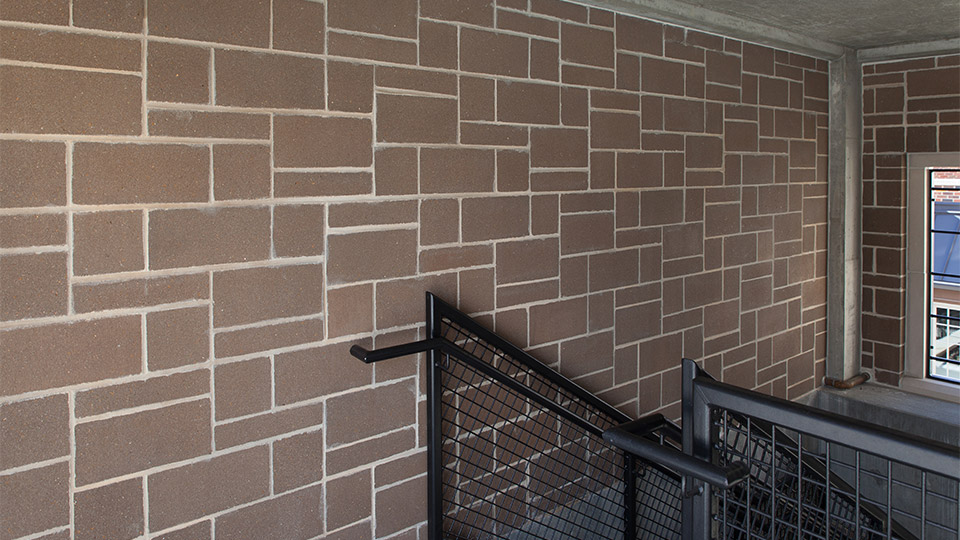
The same block used in the student center is used in the stairwell of the parking garage. This is one of the transitional uses of masonry to integrate the new elements of the church campus.
This same treatment of limestone and precast caps continues in a crash wall surrounding the surface lot of the new underground parking garage. The only above ground structure visible indicating the presence of the parking garage is the stairwell tower that leads from the surface lot to the underground parking. The limestone veneer surrounding this structure visually ties it to the church. Inside the stairwell, dark charcoal blocks set in an Ashlar pattern hint at stylistic changes in the masonry.
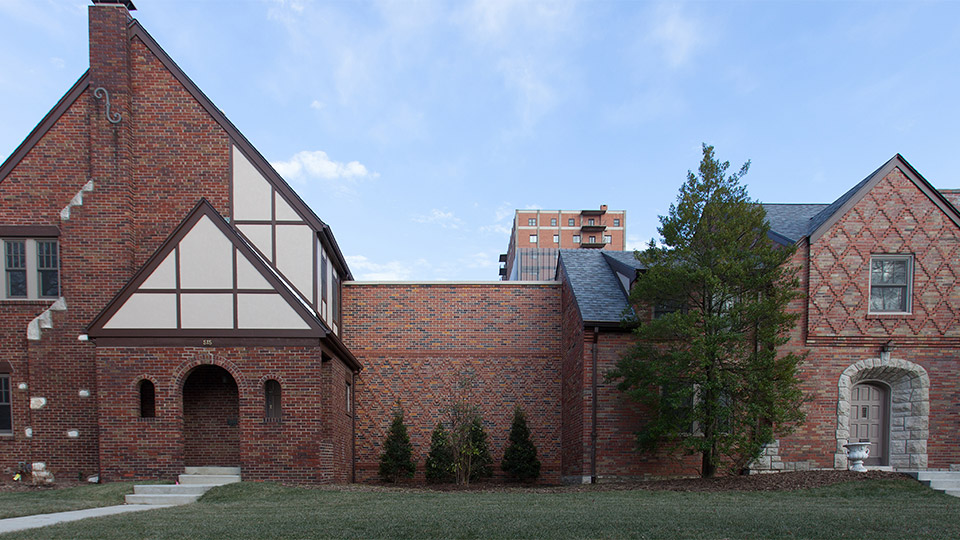
Three different colored bricks found in the original homes are blended in the new walls connecting the two neighboring properties.
“To lay true limestone and to get it to blend in well with an existing building that was built in the 1930’s takes a lot of craftsmanship,” said Stephens. “Getting the mortar to match the original is probably more important than the stone or brick material. It was important to make it look like the limestone on the handicapped accessible ramp has always been there. Mixing the right mortar is a true art form.”

This dark charcoal block with light mortar set in an ashlar pattern was selected for the walls of the student center to mimic the limestone in the church.
Work on the handicapped entrance occurred during a later phase of the project. The first stage involved the erection of the CMU walls of the new student center that would link the two existing residences purchased by the congregation. The architect designed an Ashlar pattern around three sizes of dark charcoal colored blocks set in a light mortar for the interior face of this space. This treatment mimics the light stone and dark mortar of the church, but in reverse. “There is a high degree of attention to detail that needs to be paid by the Bricklayers’ Union Local #1 of Missouri when constructing a wall with an Ashlar pattern,” said Stephens. “Arnold Masonry did a good job of puting thought into their work and making the pattern work out as they encountered changes around window openings and at corners.”

Limestone veneer on the exterior of the parking garage stairwell ties the structure to the limestone church.
This CMU block was not only selected for its aesthetics, but for its durability. The student center is designed as a multi-use facility with lots of activity. The church has taken a long view regarding the life of this building, and masonry provides the best choice for a structure that will hold up over time. “Masonry anchors are the focal point for this entire project,” said Tony Marlo, Project Manager for ICS Construction Services. “The parking garage is below deck level, but the first thing seen on Hanley Road is the new stone wall that sets the tone for the garage. As you move toward the youth center, we lose the stone and go to a brick blend with the intent of matching the two existing houses.” Midwest Block & Brick provided three different colored bricks — Bostonian, yellow and traditional red — that were blended to match and merge the colors of the two houses incorporated into the student center construction. “We had to do a lot of restoration, rehab and tuckpointing work on the buildings, as well as the new construction, to link them together,” said Jason Arnold, owner of Arnold Masonry. “We were striving for continuity to tie the old and the new together.”
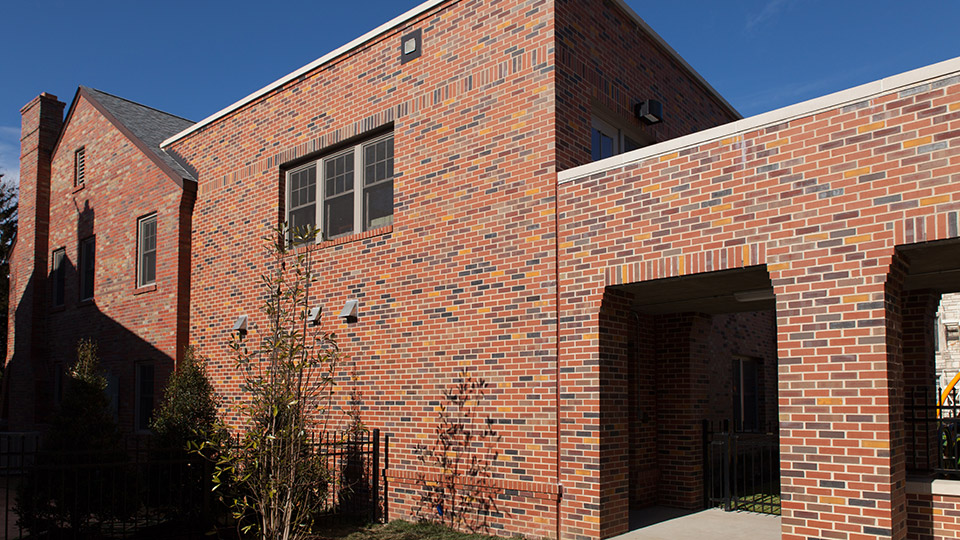
The bricklayers from Arnold Masonry successfully blended the brickwork of the new student center with the original houses.
One of the houses features a diamond pattern on its front. The architect used this diamond pattern on the brick front wall built to link the two houses together. Corbeled brickwork used on one of the houses was mimicked in the construction of the piers supporting a bridge connector from the parking garage to the student center. “I like the artistic variety of masonry. We can create so many looks,” said Stephens. “Changing the mortar colors, the scale, the size of the pieces – you can really get a lot of texture and variety of design from using masonry materials.”

This plaza between the parking structure and student center illustrates the variety of masonry products used in the campus exterior.
Eric Schmidt, Project Manager for Central Presbyterian Church, sings the praises of the new construction project. “The church has never had on-site parking or a dedicated youth center. Both are serving to significantly enhance our ministry,” said Schmidt. “I am impressed by the way the stone and brick ties the new structures in with our existing buildings. The block laid in an Ashlar pattern provides a very attractive and economical wall construction. In addition, both the neighbors and the City of Clayton have been very complimentary of our expansion.”
About the Author
The Masonry Institute of St. Louis is a promotional organization that serves as an educational and informational resource on masonry design and construction on behalf of the Mason Contractors Association-St. Louis and Bricklayers' Union Local No. 1 of Missouri. For more information, please visit www.masonrystl.org.
Photos by Michael DeFilippo
Related Articles
More Masonry Headlines



















